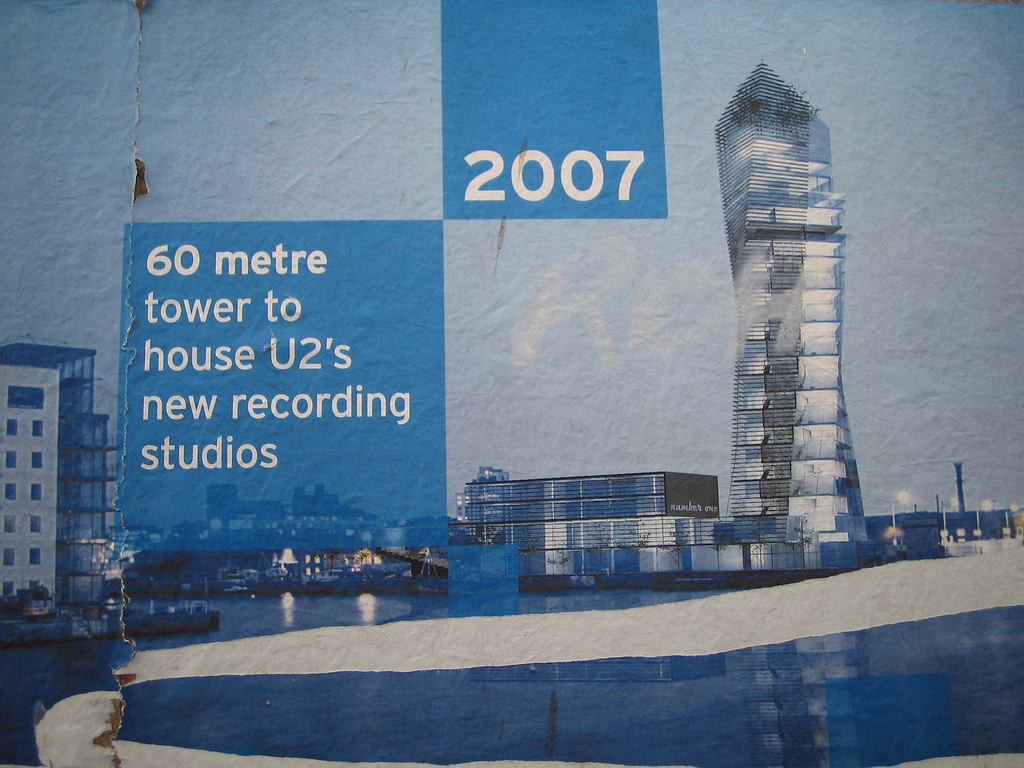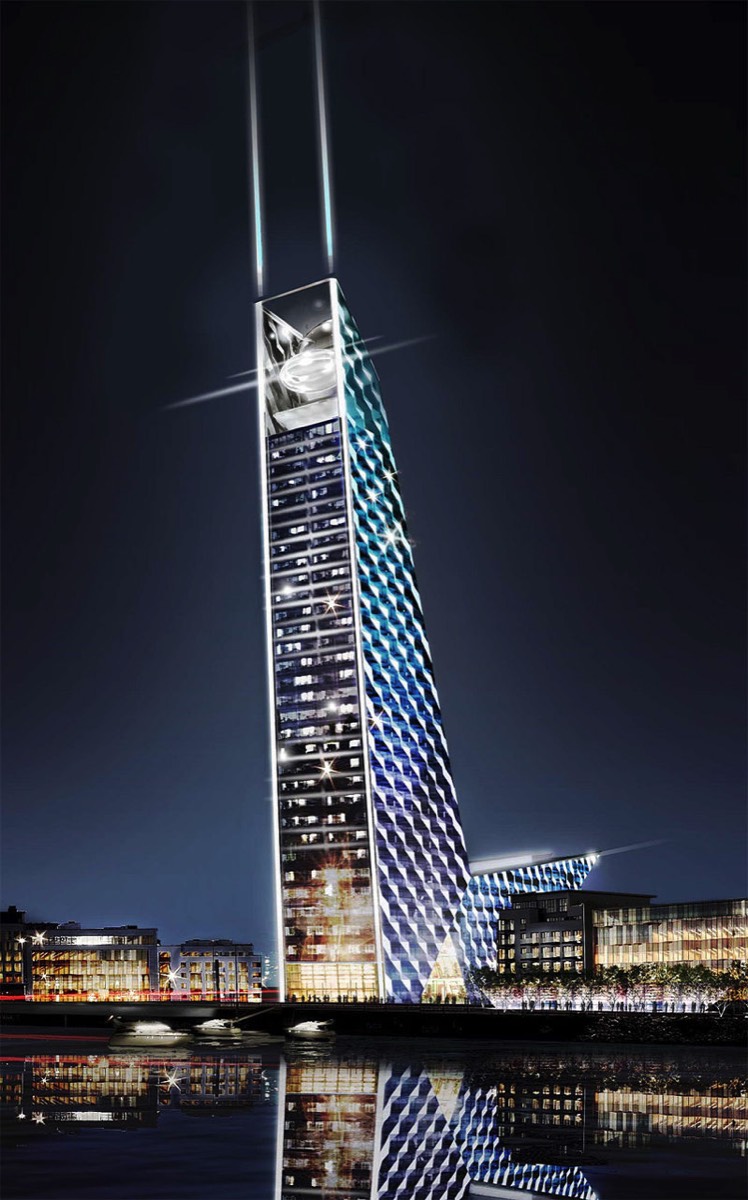THE BUILDING THAT NEVER WAS U2 TOWER
The Dublin Docklands Development Authority (DDDA) was established in 1997 to regenerate the brownfield sites and underused warehouses in the Docklands at the mouth of the River Liffey in Dublin. In 2000, the DDDA proposed a landmark tower for the Britain Quay site. The involvement of U2 was part of a deal in 2001 when the DDDA had acquired by compulsory purchase the site of U2's previous studio on Hanover Quay. In October 2002, the DDDA announced an architectural design competition for the tower, initially to be 60 metres tall, which would house apartments and a penthouse recording studio for U2. 530 entries were received from around the world by the closing date in February 2003. The judging panel was not revealed till after the winner was announced. It included the president of the Royal Hibernian Academy, the chairman and two other members of the DDDA, Dublin's City Architect, and Adam Clayton of U2.
The panel initially chose as the winner an entry which was later disqualified after legal advice because the DDDA had lost the details of which firm had submitted the design and so were unable to notify the winner. The Sunday Times later speculated that it might have been one by London practice 3W, after a campaign by Irish website archiseek.com led to six unidentified designs being located.On 5 August 2003, the winning design announced was by architects Burdon Dunne/Craig Henry (now BCDH Architects) of Blackrock, Dublin. Felim Dunne, the senior partner in Burdon Dunne, was the brother-in-law of U2's manager Paul McGuinness.
The tower's stated height was 60 metres to the parapet, but 78 metres to the pinnacle of the glass screening device.
In September 2005, the DDDA revised the height of the U2 tower from 60 metres to 120 metres. This was in conjunction with the planned construction of the 120-metre Watchtower in the Point Village complex on the north bank of the Liffey, opposite the U2 tower. The DDDA envisaged the two towers forming a "landmark entry" and "visual gatepost" for the city from Dublin Harbour.
Minister for the Environment Dick Roche approved the DDDA's plans in July 2006. The DDDA applied for planning permission for the U2 tower on 14 September 2006.This application further increased the height of the tower to 130m. The provisions of Section 25 of the DDDA Act, 1997 were used to fast-track the application. It was approved on 2 October 2006.
Tenders for construction of the tower were invited and a shortlist of five firms was published on 26 February 2007. The winning bid announced on 12 October 2007 was from Geranger, a consortium of property developers and the members of U2. The design selected was not the original BCDH design, but rather one commissioned by Geranger from Norman Foster. The bids were assessed by a panel of three architects. The runner-up was also a new design, by Zaha Hadid.
On 31 October 2008, the Dublin Docklands Development Authority announced that they were suspending construction plans indefinitely due to current economic conditions.
On 25 November 2011, it was announced that U2 Tower land had been handed over to the National Asset Management Agency (NAMA) to settle debts.
The panel initially chose as the winner an entry which was later disqualified after legal advice because the DDDA had lost the details of which firm had submitted the design and so were unable to notify the winner. The Sunday Times later speculated that it might have been one by London practice 3W, after a campaign by Irish website archiseek.com led to six unidentified designs being located.On 5 August 2003, the winning design announced was by architects Burdon Dunne/Craig Henry (now BCDH Architects) of Blackrock, Dublin. Felim Dunne, the senior partner in Burdon Dunne, was the brother-in-law of U2's manager Paul McGuinness.
The tower's stated height was 60 metres to the parapet, but 78 metres to the pinnacle of the glass screening device.
In September 2005, the DDDA revised the height of the U2 tower from 60 metres to 120 metres. This was in conjunction with the planned construction of the 120-metre Watchtower in the Point Village complex on the north bank of the Liffey, opposite the U2 tower. The DDDA envisaged the two towers forming a "landmark entry" and "visual gatepost" for the city from Dublin Harbour.
Minister for the Environment Dick Roche approved the DDDA's plans in July 2006. The DDDA applied for planning permission for the U2 tower on 14 September 2006.This application further increased the height of the tower to 130m. The provisions of Section 25 of the DDDA Act, 1997 were used to fast-track the application. It was approved on 2 October 2006.
Tenders for construction of the tower were invited and a shortlist of five firms was published on 26 February 2007. The winning bid announced on 12 October 2007 was from Geranger, a consortium of property developers and the members of U2. The design selected was not the original BCDH design, but rather one commissioned by Geranger from Norman Foster. The bids were assessed by a panel of three architects. The runner-up was also a new design, by Zaha Hadid.
On 31 October 2008, the Dublin Docklands Development Authority announced that they were suspending construction plans indefinitely due to current economic conditions.
On 25 November 2011, it was announced that U2 Tower land had been handed over to the National Asset Management Agency (NAMA) to settle debts.
SORRY FOR THE DELAY
Developers Dunloe Ewart (subsequently taken over by Liam Carroll) had secured planning permission in 2000 for a 100-metre building on a site next to that of the U2 tower. The DDDA objected to this in 2005 as it wanted the U2 tower to be an isolated landmark. Dublin City Council refused to extend planning permission on Carroll's undeveloped site after it expired. As of September 2007, Carroll was appealing this in the Commercial Court. Some residents of Ringsend have accused the DDDA of "arrogance", claiming that extra revenue from two towers could fund social housing schemes in nearby areas. Others expressed discontent at the presence of a skyscraper in a historically low-rise area.
Concerns were expressed about a possible conflict of interest for U2 in the building tender process, when it emerged that the band were joint backers of Geranger. After the original BCDH bid's success, it was pointed out that U2 manager Paul McGuinness is the brother-in-law of BCDH architect Felim Dunne.
The impact of the 2007 subprime mortgage financial crisis brought doubts on the viability of the BCDH design. Journalists speculated that the extra engineering expense of the complicated "twisting tower" design was excessive, and that an alternative design would be used instead. Construction tenders were able to submit price quotations for both the original BCDH design and an alternative of their own choosing. There has been speculation that lawsuits may be taken, by BCDH and by those builders who bid based solely on the BCDH design, that the DDDA was not empowered to scrap the original design.
Delays at all stages of the design and planning phases have been commented upon. The estimated cost and completion date moved from €55m and early 2008 in September 2006 to €200m and late 2011 in October 2007.
BCDH design
The BCDH design had a 45-degree twist, half the 90-degree twist of the Turning Torso in Malmö. It had a shoulder height of 100m, to the top floor of apartments, and a pinnacle height of 130m, including a service level and the two-storey penthouse recording studio. There were a total of 36 storeys. The footprint was a 26.6m square. The building was primarily to consist of one-, two-, and three-bedroom apartments, with commercial premises on the ground and first floors, a two-level basement parking garage, and the penthouse.
The dramatic twisting geometry of the tower posed a significant structural engineering challenge, resolved using a column structure of inclined columns following the twist of the building and the stiff circular core for torsional stability. 26.6 m² floor plates twist by an equal amount per storey about the circular core, housing lifts and services risers as well as a double-deck lift for service/firefighting and penthouse access.
Foster design
The design chosen on 12 October 2007 was a tilted triangle. It had mainly luxury apartments, with a public viewing platform at 100m, just below an acoustically-insulated egg-shaped pod containing the U2 recording studio. Above this was to be an "energy centre" containing wind turbines and a large solar panel. The east and west facades were crinkled in the manner of fish scales, with concealed balconies. The north facade would have been sleek, while the south facade had further solar panels. The building would have straddled the end of Sir John Rogerson's quay, allowing traffic to pass through its base.
Kennedy-Wilson proposal
It was reported in July 2013 that Kennedy-Wilson, an American firm, was planning to buy the site off NAMA and develop an 18-story U2 Tower, half the height of the earlier plan.
You will find links to buy products from Amazon, Google and other partners. If you click on these links, you’ll find that the URL includes a small extra piece of text which identifies that the click came from my websites. This text is an affiliate code, and it means that I get a small percentage of the money you spend if you choose to buy that product, or, in some cases, other products from the site soon after. These affiliate links help pay the costs of producing my websites and ensure that the content is free to you.
COPYRIGHT INFORMATION BELOW APPLIES ONLY TO PHOTOGRAPHS

This work by William Murphy aka Infomatique is licensed under a Creative Commons Attribution-NonCommercial-ShareAlike 4.0 International License.
Permissions beyond the scope of this license may be available at https://excellentstreetimages.com/in-the-year-twentytwenty/copyright/.


